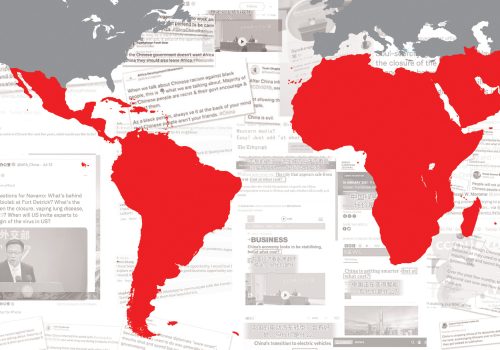Chinese discourse power: Capabilities and impact
Executive summary
This report is part of the Digital Forensic Research Lab’s (DFRLab’s) “discourse power” series, which outlines the strategy, capabilities, impacts, and responses to China’s attempts to shape the global information environment. The series argues that China’s leaders believe the country can gain the geopolitical power necessary to establish itself as a world leader, to spread its norms and values, and to decenter US power in the international system by gaining “discourse power” (话语权). In concept, discourse power is a narrative agenda-setting ability focused on reshaping global governance, values, and norms to legitimize and facilitate the expression of state power.
Whereas the first report introduced China’s discourse power strategy, this second report examines its efforts to date. This report assesses this through a frame of “media convergence” (融媒体), a Chinese term that refers to the integration of internal and external Chinese Communist Party (CCP) propaganda, the online and offline channels for its dissemination, and the mechanisms of oversight on which communications systems rely.
More specifically, this report examines “media convergence” across three vectors: channel expansion, content innovation, and governance of technological infrastructure and digital connectivity.
The first vector, channel expansion, refers to creating or better leveraging delivery vehicles for China’s messaging across different media platforms. The aim is to expose a growing international audience to Chinese narratives and norms in the hopes of eroding the global “discourse dominance” of the West. This report examines this trend through both traditional and social media. As for traditional media, China has spent over $1.5 billion annually since 2008 on propaganda, with much of that going toward initiatives in the Global South. This is especially obvious in the strategies of China’s flagship news organization, Xinhua, which describes itself as “light cavalry” in China’s global public opinion war. Xinhua has described its media strategy as using a combination of “shipbuilding to go out to sea” and “borrowing a boat to go out to sea” (“造船出海”与”借船出海”相结合)—that is, building up China’s own capacity to effectively disseminate its message internationally, while using foreign social media platforms to disseminate propaganda. As part of these efforts, Xinhua has over the years greatly expanded its networks to now have the largest number of foreign correspondents of any news agency in the world. Other strategies include both coercing and incentivizing journalists abroad to engage in more favorable coverage of China.
Chinese state entities have greatly expanded their presence on social media as well. As of January 2021, Xinhua distributed on average seven thousand three hundred articles, photos, videos, and other media content in fifteen languages daily, garnering over 200 million overseas social media followers across various platforms (including Facebook, Twitter, and YouTube). Indeed, China-based Twitter account creation skyrocketed by over 6,000 percent over a period of just three months in 2017, following reports on the situation in Xinjiang in the Western press. At the same time, however, there is a balancing act that the party-state faces when seeking to portray China as a confident leader to global audiences while also being subject to popular nationalism and domestic discontent in its actions.
As an example, tensions between different bureaucratic departments belie the official sanctioning of the assertive “wolf warrior” style of coercive diplomacy. In some instances, it appears that different elements responsible for external messaging within the Chinese government have initially contradicted each other, sometimes going as far as refuting each other’s public statements, before consolidating around a single message. One such example occurred between the Central Propaganda Department and wolf warrior diplomat Zhao Lijian around the origins of the COVID-19 virus.
Self-censorship can be a nefarious side effect of the editorial pressures that Chinese state news agencies bring—not just in China’s favor but also for authoritarian governments with which it is aligned. With regard to China’s efforts in shaping public opinion, most studies have found that China’s messaging at a general level is not especially resonant with local audiences; however, some initial studies have shown that Chinese propaganda can be effective at persuading audiences that the “China model” is superior to that of democratic political systems in delivering growth and stability. On social media platforms, Chinese officials have often engaged in coordinated influence and information campaigns, including those spreading disinformation on the origin of the COVID-19 pandemic.
The second “prong” of China’s strategy of media convergence is content innovation, which includes tailoring content (and the narratives baked into it) in a way that best resonates with a particular audience, otherwise known as “precise communication” (精准传播). China sees access to public opinion data abroad as essential to enhancing its ability to tailor content. As the party secretary and president of the online arm of the CCP’s flagship People’s Daily stated in a 2022 address, the internet “houses a vast amount of…data and is able to accurately reflect social sentiments…. Using big data [analytics] and artificial intelligence (AI), the internet can be a tool for strengthening the Party’s leadership.” To this end, China recently launched four State Key Laboratories dedicated to using big data to better tailor content to specific audiences, as well as spread “positive energy” through digital and social media.
In addition to shaping content, another tactic is to obscure the fact that the content originates from Chinese state sources. This is a phenomenon known as “political native advertising,” in which Chinese state-run media organizations purchase space in news outlets abroad to publish state-sanctioned content “camouflaged” as neutral news articles. In a 2020 report, Freedom House highlighted that, especially in digital versions of local newspapers, “China Observer”—an English-language column produced by Chinese state media outlet China Daily—often goes unlabeled as being state sponsored.
Lastly, a related strategy involves China’s attempts to control local media environments via content-sharing agreements, which in some cases end up flooding local media environments with free or low-cost pro-CCP content. A huge part of this push is to countries within China’s Belt and Road Initiative (BRI), a majority of which are in the Global South.
The last frame for examining China’s digital discourse power strategy is governance. This includes ensuring China-sponsored standards, norms, and governance protocols in prioritized industries are widely adopted, especially in the Global South. China has, for instance, been active in shaping information and communications technologies standards in the International Telecommunication Union through a “flooding the zone” strategy in which all China-affiliated members, be they from academia, private industry, or government, vote as a bloc. This ensures that standards proposals from Chinese entities end up receiving the number of votes needed to be adopted by the standards-setting body.
These exchanges serve to spread Chinese cyber norms, such as “cyber sovereignty” (网络主权), which is China’s vision for internet governance that upholds a government’s sovereign right to control the internet within its borders. The party-state spreads this norm by advising governments on how to shape laws and policies to govern the technologies (often Chinese-provided, Chinese-standard-compliant) in their own societies. This process becomes a positive feedback loop, creating a degree of both technical and policy lock-in via China-provided technical infrastructure, the standards through which it operates, and know-how and data governance frameworks. At the same time, China leverages its media relationships to flood local environments with stories of the benefits of China’s investment in developing countries’ futures.
These relationships also allow China to gain access to vast data resources. One Chinese firm outlined in this report, Nebula, uses its big data and cloud computing technologies to obtain vast amounts of data related to international public opinion on news topics related to China. It uses a variety of analysis methods, including semantics and clustering, to understand public preferences and “evaluate the difference between this understanding and media expectations…helping Chinese media build top international discourse power and influence.” The Chinese state can then use this data to hone its messages further and enhance its censorship and propaganda apparatus. It can deploy these improved tools and technologies in banal ways, like helping the tourism bureau craft a compelling narrative of “Beautiful China.” However, it can also use Nebula’s sentiment data to help the People’s Liberation Army engage in more targeted information operations and psychological warfare campaigns against countries like Taiwan.
This report finds that, anecdotally, China’s efforts gain larger ground in countries where civic freedoms are already limited and where winning the support of a small coalition of political elites matters over winning public support. In the rather extreme case of Zimbabwe, China is openly and actively antagonizing and targeting journalists and civil society activists. These findings cast doubt on assessments of Chinese influence that look solely at public opinion data. Such research may miss the fact that in some domestic contexts, China sees elite capture as much more important than winning hearts and minds.
In short, China’s discourse power efforts are uneven. While the popularity of its state and traditional media lags behind that of Western countries, its efforts to shape the environments within media and information spaces are much more effective—and are in fact the focus of China’s discourse power strategy. China is creating an alternative order in the Global South, and any effort to make meaningful progress on technological governance will need to stem from an understanding of the ecosystem that China has created, the push and pull factors facing the countries that engage with it, and on clearly messaging what the advantages of a democratic approach to such issues offers to the global majority.
Related content

The Atlantic Council’s Digital Forensic Research Lab (DFRLab) has operationalized the study of disinformation by exposing falsehoods and fake news, documenting human rights abuses, and building digital resilience worldwide.
Image: A world map of China, 3d rendering. Credit: Ran Sinee, Shutterstock.


